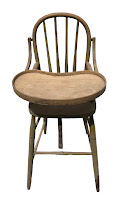 |
| Cedar Chest After |
 |
| Cedar Chest Before |
This was a solid cedar chest with a brass latch closure on the front and brass accents on the top with decorative nails in each corner. In order to do the job correctly, Jim removed the brass accents on the top and polished them, replacing the old nails with new ones that contrasted nicely with the freshly polished brass. The interior was in immaculate condition, so it required no restoration. Sometimes the interiors of cedar chests have broken elements, such as a pull-out hinged shelf. In that case the hinge would have to be replaced and the shelf repaired. (We actually have a cedar chest with this feature).
Since cedar chests can be very detailed or relatively simple in design such as this one was, they still have distinguishing features that differentiate them from others. This one had nice curved leg bottoms with a rosette design on the front. The soft curves are a nice contrast to the straight lines of the overall furniture. The front of this cedar chest had a brass latch to match the brass corner accents on the top of the chest. Over the years the locks are usually gone or have been removed to protect children from being locked inside. It's always nice to have the original hardware when refinishing a cedar chest or any other piece of furniture since finding the exact same hardware can be quite a challenge, but oh so gratifying when you do find it!
After Jim stripped and sanded this cedar chest and all the hardware was polished, he used a "natural" stain which is practically clear and protected it with two coats of satin polyurethane. The transformation was impressive and once again this cedar chest became a treasured heirloom to welcome future generations.
To see more cedar chests, please click on the links below:
https://finalefurniture.blogspot.com/2016/08/1948-lane-cedar-chest_22.html
https://finalefurniture.blogspot.com/2015/04/elegant-cedar-chest-revival.html
https://finalefurniture.blogspot.com/2013/12/1945-lane-waterfall-cedar-chest.html
https://finalefurniture.blogspot.com/2012/06/my-waterfall-cedar-chest.html





































